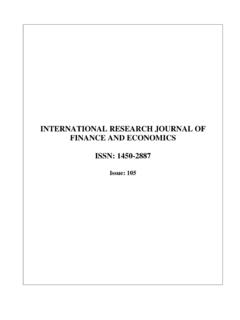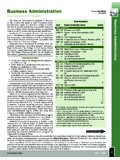Transcription of Sahoko KAJI --- Open Economy Macroeconomics …
1 Sahoko kaji --- open Economy Macroeconomics lecture notes III. III. Theories of Exchange Rate Determination The Different Theories A theory of exchange rate determination explains how the exchange rate is determined. We have several such theories today. The different theories were advanced throughout the years, reflecting the changing reality in the foreign exchange market. When a new theory was promoted, it was sometimes with criticism of the earlier theory. Today, almost three decades since a new theory of exchange rate determination was introduced, the consensus is that none of the theories are wrong. Rather, each of the theories is correct for a particular time horizon. Specifically, Purchasing Power Parity explains the long term trend in the exchange rate, over a hundred years. In the medium term between several years to decades, the flow approach to exchange rate determination has some merit.
2 And in the short term, the stock equilibrium approach to exchange rate determination explains the day-to-day determination of exchange rates. We will go over each of these theories. Purchasing Power Parity Back when currencies were exchanged mainly to conduct trade, it was natural to try to explain the exchange rate in terms of their use in purchasing goods. In one of the earliest theories, the exchange rate was considered to settle at a level where a basket of goods cost the same, whether it was imported or bought domestically. If the price of the same basket of goods was different from one country to another, arbitrage would continue until the exchange rate came to a level where the prices were the same. In other words, the equilibrium level of the exchange rate was such that the purchasing power of the different currencies was equal.
3 This was the Purchasing Power Parity theory or PPP, launched by the Swedish economist Gustav Cassel (1866-1945) in 1921. In a simple model with only one good produced both at home and abroad, PPP is expressed as P eP . The real exchange rate is equal to one when PPP holds. Later on, Cassel's original theory came to be recognised as the Absolute PPP , in contrast to the newly introduced Relative PPP . The latter focuses on the rate of change instead of the level of the nominal exchange rate. We choose a period in time when the exchange rate was at a level that most closely reflected the international competitiveness of the two countries involved, and use it as the reference period. Between this reference period and today, inflation rates would have been different in the two countries. The exchange rate today is at the relative PPP level if it has changed in just such a way that cancelled out these inflation differentials.
4 Needless to say, for this theory to stand, the reasons behind the choice of reference period III-1. Sahoko kaji --- open Economy Macroeconomics lecture notes III. must be robust. There should also not have been any new trade barriers introduced between the reference period and today. Furthermore, if the price index used to calculate inflation differentials included both prices of traded and non-traded goods, we may have the Balassa-Samuelson effect . This is when the international competitiveness of traded-good industries in a country with high growth is underestimated (or the real eP . exchange rate is overestimated). It happens because the non-traded goods sector is P. less efficient than the traded-goods sector, and non-traded goods prices tend to rise more rapidly than traded good prices, in countries with high growth.
5 The Flow Approach to Exchange Rate Determination Eventually, economists began to see the exchange rate as an instrument to bring about balances in the current account. This went on until the mid-1970s. Capital controls were still in place, demand for and supply of foreign exchange were trade-related, and the major exchange rates were fixed under the Bretton Woods System. In such a world, current account imbalances were serious problems that interfered with stabilisation of the domestic Economy . Participants of the Bretton Woods System were obliged to maintain fixed exchange rates and stable current accounts. This obligation took precedence over domestic policy concerns. When macroeconomic policy stances desirable for domestic stabilisation were inconsistent with the requirements of being part of the Bretton Woods System, the latter prevailed over the former.
6 (Recall the loss of monetary policy autonomy when the exchange rate must remain stable, as shown by the Inconsistent Triangle.). Seeing this, economists such as Milton Freedman began to advocate freeing the exchange rate, to use the exchange rate as an instrument to bring about current account balances. Exports give rise to supply of foreign exchange; imports give rise to demand for foreign exchange. Hence exports were equal to imports and the current account was in balance, when supply was equal to demand in the foreign exchange market. If exchange rates were allowed to float, therefore, they will settle at levels that made demand equal to supply, freeing us of the problems caused by current account imbalances. It was natural to see the demand and supply as flow variables, because exports and imports were flow variables.
7 And this came to be called the flow approach to exchange rate determination. The flow approach was at first shown in a partial equilibrium model of the current account as a function of real exchange rates. An example of such an elasticity approach is shown below when deriving the Marshall-Lerner condition. Later on, the flow approach took on a general equilibrium framework, placing the current III-2. Sahoko kaji --- open Economy Macroeconomics lecture notes III. account in the IS equation. This was called the absorption approach because it emphasised the importance of the discrepancy between aggregate supply and domestic absorption (domestic absorption) as the cause of current account imbalances. In any event, the flow approach to the theory of exchange rate determination was inseparable with the question of how to bring about current account balances.
8 The Stock Equilibrium Approach to Exchange Rate Determination As it turns out, after floating, the exchange rates did not bring about current account balances. This was because floating coincided with the gradual removal of capital controls. In Japan, for instance, controls began to be gradually relaxed and international capital flows began to increase in the late 1970s. Before the changes in the foreign exchange law (Gaitame-ho) in December 1980, foreign exchange transactions were prohibited in principle, free as an exception . After the changes, they became free in principle, prohibited as an exception . After removal of capital controls, foreign exchange markets became increasingly dominated by demand and supply unrelated to trade. Households, financial institutions and firms began to invest in financial and real assets all over the world.
9 Exchange rate movements became more and more volatile and quick. Penti Kouri was one of the first to argue that it was more appropriate to define demand and supply in the foreign exchange market in terms of stocks, as opposed to flows ( Kouri (1976), The Exchange Rate and the Balance of Payments in the Short run and in the Long run: A Monetary Approach , Scandinavian Journal of Economics). This would allow us to explain why the equilibrium level of the exchange rate changed from moment to moment. Flow variables can only be defined over a period of time, while stock variables can be defined at each moment. Stock demand and stock supply can be defined and change from moment to moment, leading to equilibrium price changes from moment to moment. The exchange rate should be seen as one of the asset prices that were determined in stock equilibrium, as the result of portfolio decisions of asset holders.
10 This idea turned out to be extremely insightful, and led to the stock equilibrium approach. It correctly incorporated the increasing importance of the capital account and the currencies' role as a store of value (in contrast to the current account and the currencies'. role as a medium of exchange) into the theory of exchange rate determination. We were no longer paying attention solely on the left-hand side of the CA S I equation. Furthermore, the theory succeeded in explaining the rapid changes in the exchange rate, and introduced the notion of difference in adjustment speed among the endogenous variables in macroeconomic models. III-3. Sahoko kaji --- open Economy Macroeconomics lecture notes III. An example of a Model using the Stock Equilibrium Approach Here is an example of a simple model using the stock equilibrium approach.






